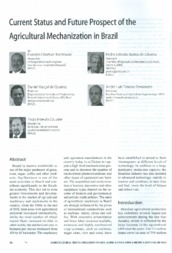Current status and future prospect of the agricultural mechanization in Brazil.
Current status and future prospect of the agricultural mechanization in Brazil.
Author(s): MANTOVANI, E. C.; OLIVEIRA, P. E. B. de; QUEIROZ, D. M. de; FERNANDES, A. L. T.; CRUVINEL, P. E.
Summary: Brazil is known worldwide as one of the major producers of grain, meat, sugar, coffee and other products. Agribusiness is one of the main activities in Brazil and contributes significantly to the Brazilian economy. This fact led to even greater investments and developments in the market of agricultural machinery and implements in the country. From the 1960s to the end of 2018, land areas with agricultural potentia1 increased substantially, while the total number of wheel tractor fleets increased six-fold; in other words, the mechanized area in hectares per tractor decreased from 410 to 65 ha/tractor. The machinery Pedro Estevão Bastos de Oliveira President Chamber of Agricultural Machinery and Implements (CSMIA) ABIMAQ pedro@jacto.com.br BRAZIL André LuísTeixeira Fernandes President Brazilian Society of Agriculture Engineering - SBEA andreJernandes@uniube.br BRAZIL and equipment manufactures in the country today is sufficient to support a high-level mechanization process and to decrease the number of tractors/seed planters/combines and other types of equipment per hectare. The acquisition and modernization of tractors, harvesters and other equipment types depend on the income of farmers and governmental and private credit policies. The sales of agricultural machinery in Brazil are strongly influenced by the prices of international commodities such as soybean, maize, citrus and coffee. With excessive urbanization and fewer labor resources available, extensive and highly mechanized crop systems, such as soybean, sugar cane, rice and corn, have been established to attend to farm chronograms at different levels of technology. In addition to a large machinery production capacity, the Brazilian industry has also invested in advanced technology, mainly in tractors and combines, to save time and fuel, lower the level of fatigue and reduce cost.
Publication year: 2019
Types of publication: Journal article
Unit: Embrapa Maize & Sorghum
Keywords: Equipamento Agrícola, Maquina Agrícola, Mecanização Agrícola
Observation
Some of Embrapa's publications are published as ePub files. To read them, use or download one of the following free software options to your computer or mobile device. Android: Google Play Books; IOS: iBooks; Windows and Linux: Calibre.
Access other publications
Access the Agricultural Research Database (BDPA) to consult Embrapa's full library collection and records.
Visit Embrapa Bookstore to purchase books and other publications sold by Embrapa.

